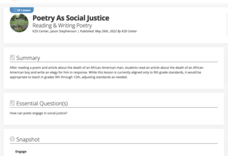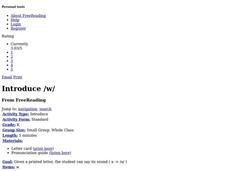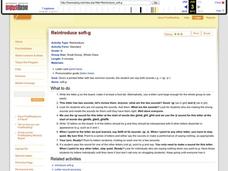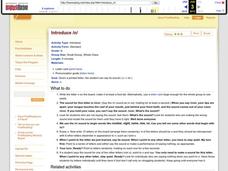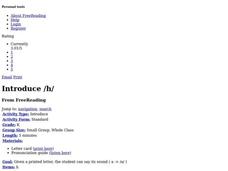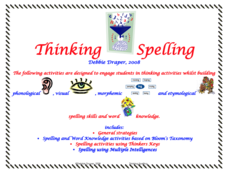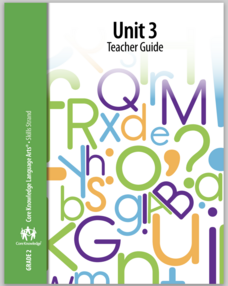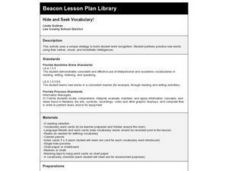Curated OER
Is Your Money Rolling Away?
Young scholars demonstrate how to solve word problems. They will watch the video "Math Can Take You Places" and identify three problem solving strategies.
Curated OER
Segmenting and Blending with Word Families
Students sound out CVC words. In this literacy instructional activity, the teacher guides students through the process of sounding out three-letter words with a as the middle vowel using both repetition and movement. Then students...
K20 LEARN
Poetry as Social Justice: Reading and Writing Poetry
Words can be a powerful tool in the hands of a poet. Class members examine a poem written by Ross Gay in response to the death of Eric Garner and a news report of the same death. They then read an article about the death of Tamir Rice...
Curriculum Corner
Converting Metric Units of Length Brochure
How many millimeters are in 10 meters? Which is greater: two centimeters or 30 millimeters? These are the types of questions learners can solve, along with one word problem, in a six-sectioned measurement brochure.
Curated OER
Introduce /w/
Get to know the ins and outs of the letter w using these strategies combining pronunciation, recognition, letter sound, and word examples. Scholars examine the letter shape and listen to you pronounce the /w/ sound. Use these tips...
Curated OER
Reintroduce /t/
Use these strategies to connect letter pronunciation, sound, word examples, and recognition, focusing on the letter t. Emerging readers examine the letter and listen to you say the /t/ sound. As you explain how to do it, they try...
Curated OER
Reintroduce Soft-g
Do your scholars know that the letter g sometimes steals the j phoneme? Explore the letter g using these strategies combining pronunciation, recognition, letter sound, and word examples. Scholars examine the letter...
Curated OER
Introduce /n/
What is this letter? Once your class is ready to explore the letter n, use these strategies to combine word examples, pronunciation, and letter recognition. First, can they identify the letter? Make the /n/ sound, explaining...
Curated OER
Introduce /h/
Explore the letter h using these strategies combining pronunciation, recognition, letter sound, and word examples. Scholars examine the letter shape and listen to you pronounce the /h/ sound. As you explain how this sound is...
Curated OER
Introduce /j/
Learn the ins and outs of the letter j using these strategies combining pronunciation, recognition, letter sound, and word examples. Scholars examine the letter shape and listen to you pronounce the /j/ sound. Use these tips to...
Curated OER
Reintroduce /v/
Combine letter recognition, sound, and pronunciation using this strategy for pre-readers. Use these letter cards or write the letter v on the board, asking scholars to identify it. Then, model the /v/ sound as you explain how...
Curated OER
Introduce /o/
The best way to get your scholars familiar with the alphabet is to expose them to each letter in multiple contexts. This strategy incorporates letter recognition, sound, word examples, and pronunciation, and emerging readers will feel...
Curated OER
Introduce /g/
As your emerging readers are learning the alphabet, set them up for success with strategies like these that incorporate multiple contexts and learning styles. Focusing on the letter g, write it clearly on the board. Model the /g/...
Curated OER
Introduce /y/
As you come to an end in your alphabet study, use these strategies to examine the letter y. Scholars examine the letter shape and listen to you pronounce the /y/ sound. Use these tips to explain how you do it as they try. Can they...
Curated OER
Thinking Spelling
An etymology resource is packed with suggestions for activities designed to build phonological, visual, morphemic, and etymological spelling skills.
Curated OER
Tomato Exploration
Create tomatoes in 15-20 minutes using this fun and interactive lesson plan! Learners listen to a book about tomatoes (recommendations listed), and focus on the vocabulary word tomato. They count the syllables...
Positively Autism
"When I Feel Angry" Social Skill Story
Here's a presentation that shows kids appropriate ways to behave when they are feeling angry. They learn how to identify when they are feeling angry, calming strategies they can use, and words they can use to express their anger. The...
Core Knowledge Foundation
Taking Care of the Earth Tell It Again!™ Read-Aloud Anthology
A read-aloud anthology closely examines human impact on the Earth while boosting reading comprehension skills. Through stories, scholars examine the concepts of natural resources, pollution, garbage, and recycling and brainstorm...
Core Knowledge Foundation
Second Grade Skills Unit 3: Kids Excel
The unit offers second graders skills practice in tricky spelling and words, grammar—nouns and punctuation, reading decodable texts, and writing a personal narrative. Lessons begin with a warm-up and go into a concept review, word work,...
Core Knowledge Foundation
The War of 1812 Tell It Again!™ Read-Aloud Anthology
A read-aloud anthology consists of eight lessons about the War of 1812. Over 12 days, pupils listen to and discuss readings, practice word work, then complete extension opportunities designed for the class and home. Assessments gauge...
Curated OER
Hide and Seek Vocabulary!
Third graders practice word recognition and vocabulary building. They find word cards in the classroom. Then they practice reading the words and using them in sentences. Additional practice is gained by writing the words and using them...
Curated OER
Problem-Solving Strategy: Make an Organized List
In this problem-solving worksheet, students utilize the strategy of making an organized list to solve a mathematical word problem in 5 steps.
Curated OER
Color Coded Reading
Students read text that is color coded to make it more exciting to read. In this reading lesson plan, students read text that is in different colors or highlighted differently in order to be inspired to read in front of the class.
Curated OER
Spelling Strategies for Success
Students identify the meaning of the suffix "er" in given words and sort according to meaning. Students pair up for proofing of work, checking for correct sorting of words in categories of: no suffix, suffix that means "more," and...




